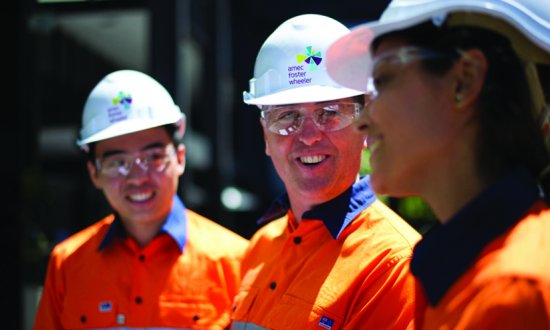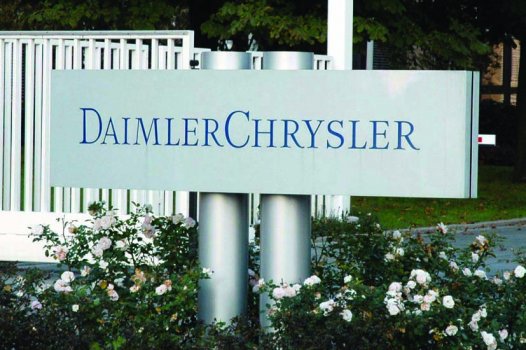
NOT JUST A FRESH COAT OF PAINT
Mergers require communicators to act skillfully during a challenging time period. Friendly mergers, David Benady writes, often succeed due to the effectiveness of M&A communications
Thousands of employees at the newly-merged Amec Foster Wheeler engineering group had something of a shock when they turned up for work on 13 November, 2014. Unknown to them, their offices had secretly been rebranded overnight with new branding and logos to mark the official “day one” of the merger between the UK’s Amec and Foster Wheeler of the US.
Smashing together the two energy infrastructure giants was an elaborate task. After announcing plans for the cross-border merger in February 2014, Amec’s communications team used both chief executives’ blogs to keep staff at the two businesses up to speed. But what they didn’t know was when the legal teams would sign off the deal and allow it to become a reality; the day one of the combination.
“We were gearing up for that day in our communications efforts,” says Tereza Urbankova, Amec Foster Wheeler’s head of internal communications. “We launched the new identity, vision and values, we rebranded 24 key offices overnight – people left the day before and came back the next day into the offices and the branding had been changed.” The deal was not officially sealed until day one, so the two companies were still separate and the new branding couldn’t be launched until the go-ahead was given. Urbankova says the overnight rebranding was a big surprise for quite a few people, but adds, “The element of surprise was a nice thing to have under the circumstances.”
Mergers are never easy – there can be culture clashes, disruption, regulators on your back and struggles between rival staff for fewer jobs. Getting the final sign off by lawyers can take an age, and the two companies have to continue competing like hell even though they hope they will soon become one. Some mergers can unravel completely – the combination of French ad giant Publicis and US rival Omnicom fell apart last year, while the doomed DaimlerChrysler merger was a case study in failed corporate logic and botched communications.
But if communicators can create powerful and convincing narratives to explain the purposes and logic behind a merger and present the argument in a powerful way, the chances of success will increase greatly.
Every merger is different, and the key stakeholders that need to be addressed vary. For the recently announced merger between UK betting businesses Ladbrokes and Gala Coral, getting the deal past regulators at the Competition and Markets Authority is the biggest challenge. The merger will create a gigantic business comprising 4,000 betting shops, accounting for nearly half the market. The businesses are set to stay separate for up to a year as the two boards attempt to get the merger past regulators without too many onerous conditions.
“When you get down to it, the role of comms people really makes a difference. How do you take the concept of the merger and turn it into real language and real examples of what’s going to happen on the ground?”
One of the first significant tasks in any merger is allocating roles to executives from the separate companies, which is known as the ‘social’ aspect. This is important in persuading shareholders and investors to back the merger and to showing the deal has been well thought-through. Ladbrokes and Coral have already sorted out the proposed board structure.
Andrew Grant, founder of Tulchan Communications who has advised on this and many other merger and acquisition (M&A) deals, says, “The external perception of the balance of the board is very important. Mergers often fail on the social issues, on who gets what job.” Ironing out duplication can be particularly sensitive for the two communications teams in a merger, as they have to work closely to bring the combination to fruition. But they know that ultimately only one of the teams is likely to stay on. Grant says this is no great stumbling block, “The market for good comms people is strong, a good comms director can always find another role.”
The Ladbrokes communications team is led by Donal McCabe, who worked on the Boots/ Alliance merger. He will work closely with Gala Coral’s director of corporate communications Fiona Thorne, the former chief executive of PR agency Fishburn Hedges. McCabe says that everything to do with the merger is on hold until the deal gets the go-ahead from regulators, “As comms teams we are well used to being united on industry matters and fighting for common causes, but at other times, we are trying to eat each others’ lunch. Nothing is going to change in the run up to the merger. If we get to the point where the merger goes ahead, that is when we’ll have a conversation about taking the communications forward.”
Grant says mergers require huge amounts of work from comms teams. “When you get down to it, the role of comms people really makes a difference. How do you take the concept of the merger and turn it into real language and real examples of what’s going to happen on the ground?” He points to a long lists of tasks at hand. “They have to write the press release and documents that go to both sides, there’s a ton of supporting materials, they have to set up the presentation – who is on the stage, where do they sit, who gives what section of the presentation, what is the balance of people presenting? There is a huge amount of work led by the comms people on both parts.”
 Meanwhile, veteran journalist Damian Reece, former business editor at the Telegraph Group, who is now a managing partner at communications agency Instinctif, says, “Having observed mergers and acquisitions over 23 years, it is clear to me that at a very basic level, effective communications can ultimately mean the difference between a successful transaction and one that fails.”
Meanwhile, veteran journalist Damian Reece, former business editor at the Telegraph Group, who is now a managing partner at communications agency Instinctif, says, “Having observed mergers and acquisitions over 23 years, it is clear to me that at a very basic level, effective communications can ultimately mean the difference between a successful transaction and one that fails.”
He says M&A related communications have become much more complex over the years as the number of key audiences has increased and business activity has become more politicised. Politicians now need to be persuaded about the benefits of a merger far more than ever before. Rupert Murdoch’s plans to merge BSkyB with his other UK businesses in  2010 were derailed by political concerns; the eruption of the phone hacking scandal putting a spanner in the works of his attempts to create a combined company.
2010 were derailed by political concerns; the eruption of the phone hacking scandal putting a spanner in the works of his attempts to create a combined company.
Reece also points to Pfizer’s failed attempt at taking over AstraZeneca last year. “Pfizer got its communications wrong, particularly in relation to the political audience including mainstream media. The message and the rationale of the deal were not clear and allowed the other side to take advantage,” he says.
Many of these problems stem from the wish to please all of the people involved in a merger, when there often have competing needs. The interests of shareholders may diverge significantly from those of politicians and employees.
 There is a balance to be struck between creating a compelling overall narrative for all stakeholders and targeting different messages to each group. This can be tricky, as giving out different messages can come across as duplicitous. “Messages that might be relevant for financial stakeholders – such as cost efficiencies – can set alarm bells ringing among employees,” warns Daniela Stawinoga-Carrington, vice president of international corporate relations at Ketchum. “One size fits all is definitely not the right way to go,” she says. “The key from what I’ve seen is for the communications departments to work together. The value of the merger, the implementation, the corporate vision, depends on your employees. Balance the cost cutting message with ensuring your key value drivers – your staff – are still motivated and on board.”
There is a balance to be struck between creating a compelling overall narrative for all stakeholders and targeting different messages to each group. This can be tricky, as giving out different messages can come across as duplicitous. “Messages that might be relevant for financial stakeholders – such as cost efficiencies – can set alarm bells ringing among employees,” warns Daniela Stawinoga-Carrington, vice president of international corporate relations at Ketchum. “One size fits all is definitely not the right way to go,” she says. “The key from what I’ve seen is for the communications departments to work together. The value of the merger, the implementation, the corporate vision, depends on your employees. Balance the cost cutting message with ensuring your key value drivers – your staff – are still motivated and on board.”
Another key element in smoothing the way to a successful merger is making sure that employees find out about the situation from the companies themselves, rather than reading about it in the press or on social media. This can be challenging for multinational corporations with operations in dozens of countries, but it is vital to control the flow of information. It requires a huge amount of central coordination, though with local communications teams given the freedom to tell the story in their own way. “Most employees want to hear about it internally first, not read it in the paper or through Twitter,” says Ben Burton, managing director for corporate at Weber Shandwick. “You need to ensure with sensitive information you have teams fully aligned so you don’t have any internal wrangling and people thinking they are not well informed,” he adds. Some markets might require face to face meetings, while in other cases the information can be sent via email. There will be many staff, especially in manufacturing businesses, that may not have access to the internet while they work, so will need to be told via a public meeting.
There are clearly difficulties in coordinating these announcements across time zones and different continents. Burton suggests a “follow the sun” approach, in which announcements are made in markets that wake up first, then go across time zones as the sun rises on them. This way, information can be relayed so everyone gets it on the same day and the risks of the media or social media putting an unwelcome spin on the story are minimised.
Employees may go through a so-called change curve when their business is involved in a merger, moving through anger and possibly on to despair before adopting a more positive attitude to the new situation. Victoria Lewis-Stephens, managing partner for engagement at Instinctif Partners, says that communicators need to help people move along that curve by explaining the reasons and benefits of the merger. But this can never be the role of just one department, she says – human resources and the leadership team must also be involved. “The comms function can often be seen as just relaying information. They have to be on the front foot, they have to think ahead of the game so they can start to help the new world. If they continue to work in silos, that’s a real problem.”
She argues that there are ways of getting the staff far more involved in shaping the future of the merged company. “It takes a comms function or human resources function to say rather than us designing how this should work, get the people involved to shape what this should look like,” she says. She sees a merger as an ongoing journey. But she adds that there is a risk that productivity slips during a merger as employees put work on hold to gossip about how it will affect their jobs. “As much as you need to paint a vision of the future to help them understand the benefits of the merger, you also need to keep them focused on the here and now, to continue focusing on the clients and what the business will look like.”
At Amec Foster Wheeler, the merger is going well so far, though it has coincided with a slump in oil prices and fewer energy projects. The combined group with some 50,000 employees in 60 countries, has worked with agency BrandCap for the rebranding. Of course, the rise of digital communications makes such global mergers easier and the company has created a common website.
Getting staff on side can take many forms – Amec did a desk drop, placing a booklet on the desktop of every employee explaining the deal and offering them a commemorative gift – a medal celebrating the merger. But hearing the feedback is also vital. Internal comms chief Urbankova says, “There is a big piece on listening, we had so much feedback from all parts of the company even on day one. Addressing these questions and responding in time so people feel they are being heard is absolutely crucial.”
Most friendly mergers don’t unravel, though there are serious questions as to how much extra value they really create for investors, for staff and for society as a whole. To extend the odds of success, communicators have to get the story straight. But it can be a huge challenge to persuade all stakeholders that they stand to benefit equally.



